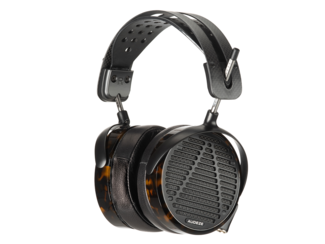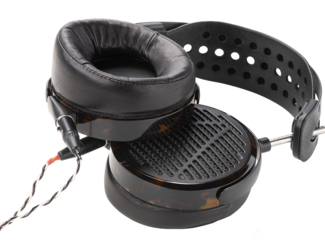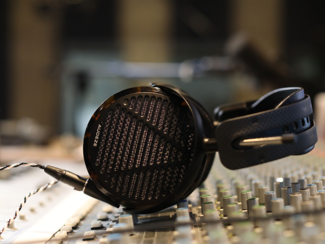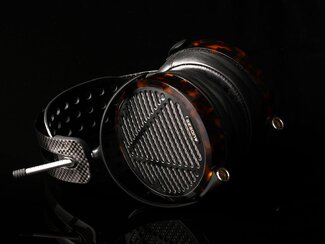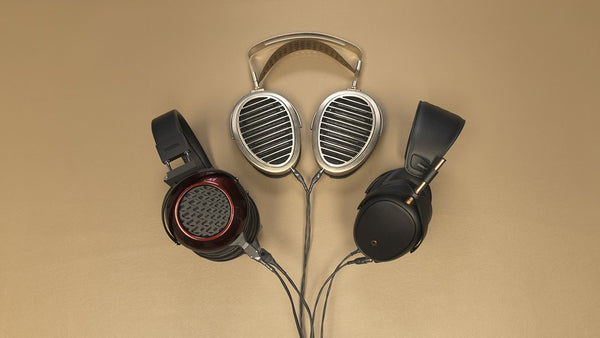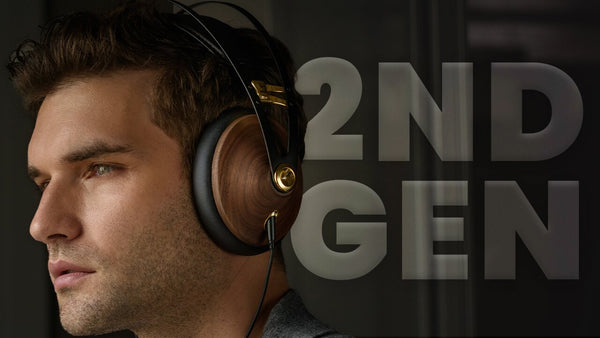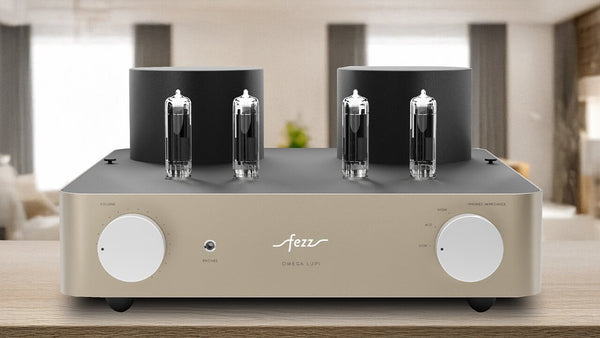Audeze LCD-5 Headphone Review
Read Time: Approx. 14 min.

Transparency, Resolution & Speed at Only 420g
Some headphones are beautiful but only sound OK. Other headphones sound phenomenal but their styling leaves something to be desired. And then there are the headphones that score high points in both departments. One such headphone is the new flagship Audeze LCD-5. The California company makes some of the finest planar magnetic headphones out there, including its LCD series and gaming headphones like the Mobius and Penrose. At $4,500, the LCD-5 costs $500 more than the LCD-4 that came out in 2018. But technology advances, material costs rise, and prices go up. The LCD-5 represents more than minor updates to previous LCD models. In fact, everything has been improved: drivers, ear pads, frame design. According to Audeze, New Parallel Uniforce™ diaphragms and Fluxor™ Magnets provide powerful sound, unparalleled sonic detail, and incredible accuracy without increasing the impedance — which is a low 14 Ohms.

PROS
- One-third the weight of the LCD-4
- Clarity and instrument separation
- Great for critical listening
- Attractively styled
CONS
- May have too much high-end presence for some
- Price may deter some buyers
Design
For me, it was love at first sight. I love everything about the LCD-5 aesthetic. My eyes are smiling no matter where I rest them:
- The black perforated head strap and sleek black carbon-fiber headband
- The tortoise shell finish on the acetate rings
- The notched silver stems with black tips
- The big, pillowy, premium leather ear pads
- The all-new magnesium housing
- The cool design on the inside of the ear cups
- The grille design
But it's not just about the looks; it's about the lower weight and size of the headphone. If you know Audeze headphones, you know they can be BIG — and not just large, but heavy. The LCD-4 weighs 690g — that's 1.5 pounds! The LCD-5 cuts that by a third, coming in at 420g, or just under 15 ounces. Not only does the LCD-5 weigh less than a pound, it has a nice, compact look to it, including the smaller ear cups. And I love that I can easily hold the LCD-5 with one hand. (OK, technically I can hold any headphone with one hand. But the LCD-5 fits especially well in my hand.) Audeze also improved the structural design incorporating magnesium, acetate, and carbon fiber to accomplish a lighter weight (⅓ less than the LCD-4) and therefore more comfortability.
You know what else fits nicely in my hand? The black aluminum travel case that comes with the LCD-5. It's kind of like a giant old-school lunchbox, but much cooler looking. There is a notable lack of branding on the case, though you're not likely to forget what's inside.
As far as comfort, I think it goes without saying that the lighter weight of the LCD-5 makes it a very comfortable headphone.
Look, I love Audeze headphones for their sound. But throw the LCD-4 on my head and I'm not going to last too long. Fabulous-sounding headphone, mind you. But it's not ideal for long hours of listening. Clamping force is solid, allowing me to turn and shake my head without having to make adjustments.
The LCD-5 cable is specially tuned with directional OCC high-purity copper strands that provide a low capacitance and low resistance path for the signal to travel from your amp to the drivers, maintaining unsurpassed clarity and precision.
Sound
Audeze's LCD series headphones run the gamut when it comes to sound signature. The LCD2 and LCD3 have some warmth and musicality with huge low ends, while the LCD-4 and LCD-4z are analytical with a smooth top end. Then you've got the LCD-MX4, LCDX, and LCD-GX, which are more forward sounding.
Similar to the LCD-4, the LCD-5 has an analytical sound, but its top end has more sizzle. Upper mids, including vocals, are on the forward side, and bass is tight and punchy. The sound is spacious and clean.
Fresh off a live symphony performance, I started my test session with some classical music. When I listened to Brahms' Symphony No. 1 performed by the Budapest Symphony Orchestra, I was immediately transported back to the previous day's concert hall, with my mind's eye easily able to picture the various sections on the stage based on the sounds filling my ears. The flutes and violins exemplified the top-end sizzle, really waking up my senses and making my ears dance. The drums had a satisfying resonance that very nicely stayed in their zone, never overpowering the rest of the instruments.
I also listened to a live performance of Bach's Cello Suite No. 1 performed by Yo-Yo Ma. This is a lovely performance that really gives the listener a sense of the performer's command of the stage. What struck me here was that the cello might have sounded too rich on a warmer headphone, but it sounds just right on the LCD-5. On both of these pieces, I appreciated the dynamic range of the LCD-5. I didn't have to lower or crank the volume when the music became softer or louder.
Turning to my more default classic rock setting, I called up Fleetwood Mac's Rumours. I intended to listen to just a track or two, but before I knew it I had let the album run through. Clearly the LCD-5 was doing something for me here. On the first track, "Second Hand News," I loved the grit and thump of the main guitar-plus-drum rhythm that sounds like a locomotive. The track sounded so lively and tight. Moreover, Stevie Nicks' and Christine McVie's backing vocals were so clearly delineated that I could easily switch back and forth between theirs and Lindsay Buckingham's lead vocals. I loved that I could easily focus on the vocals as easily as I could discern the acoustic strings that kept popping up in my left ear. The rest of the album was great. The plucking of the strings on the acoustic "Never Going Back Again" was magical, providing a little tingle to my brain. And Buckingham's voice sounded like it was being sung directly into my ears.
On Natalie Merchant's "Beloved Wife," a slow, gut-wrenching track about an elderly man's loss of his longtime spouse, I really got a sense of the more forward middle and middle high frequencies on the LCD-5. This slow and somber track has a fair amount of bass to it, and sometimes that bass can overpower the song. This time, Merchant's vocals and the piano were the most forward elements, with the drums and guitar being perfectly audible and complementary but not center stage. Merchant has a rich voice that sometimes lacks enunciation. With the LCD-5, I felt like her vocals sounded a little clearer than they sound on a warmer headphone or a headphone with less clarity.
Finally, I listened to Jethro Tull's "Skating Away on the Thin Ice of a New Day," a track I often use in my headphone testing. You may know from my previous reviews (or maybe you know the song), but the prelude features frontman Ian Anderson making tea. A headphone with lots of detail and clarity will really make this sequence pop, to the point where you can "feel" the teaspoon on the back of your neck when it clinks against the cup. This and the whole rest of the track sounded amazing on the LCD-5. The flute and bells had lots of sparkle and zing, and instrument separation was strong in the more frenetic parts of the song. What really stood out to me on this track was the tightness of the bassline. It's easy to get swept away by the treble as well as the powerful guitar blasts, but somehow hearing that bassline kept the song grounded and even more interesting.
Sound summary: Neutral/analytical with forward upper mids and vocals. Tight, punchy, deep bass. A spacious sound with great imaging.




Features & Technology
Newly designed low-profile Fazor waveguides are optimized to reduce diffractions
Audeze likens sound waves to a series of ripples in a pond. If you drop a single pebble into a flat surface of water, it produces a series of waves, radiating outward in a circle. Drop two pebbles in two different locations, and the ripples will both try to radiate in a circle, but when one wave crashes against another, it distorts that wave, causing it to change shape, speed, and direction. This same phenomenon occurs in audio, and is known as “wave interference.” Wave interference, although a larger issue for speakers than for headphones, is still a major obstacle in high-performance headphone audio.

Audeze has developed a patented technology to combat this interference. Think of Fazors like guides for sound, maneuvering the sound waves out of the drivers in an even and smooth way without interfering with each other. Each Fazor element is placed just outside the magnets that drive the diaphragm, allowing the sound waves out in a more even and parallel direction, reducing interference and diffraction, or scattering of sound waves.
By reducing the resistance to the natural flow of sound waves, Audeze’s Fazor arrays accomplish multiple goals while adding minimal weight and greater performance. They not only extend high frequencies, they also allow greater efficiency, and help keep the Fluxor magnets acoustically transparent. This is because they help sound waves pass through the magnet structures unhindered, causing less degradation and interference by the mass of the magnets themselves.
Diffraction of sound off the magnets can cause different frequencies to arrive at different times, which results in changes in phase (essentially the timing of the sound waves relative to each other). With Fazors, sound waves generated by the large planar magnetic diaphragms pass through magnetic structures without disturbance, preserving timing details in the recorded signal. This ultimately results in cleaner sound, greater resolution, and better imaging, as well as allowing the diaphragm to settle faster and with less “ringing.”
Award-winning Fluxor Magnets
Fluxor magnetic technology allows Audeze to create a stronger magnetic field for the same weight. Here's why this matters:
- Ergonomics: Fluxor magnets allow Audeze to develop lighter headphones, making use of a smaller number of magnets without making them harder to drive. Audeze has been able to create lightweight designs, such as those found in LCD-i3 and LCD-i4 IEMs, that employ a single-sided Fluxor design yet maintain a high degree of control over the diaphragm.
- Resolution and transparency: The very strong magnetic field generated by the Fluxor magnets allows for incredible control over the diaphragm, resulting in some of the best resolution you’ll hear. The LCD-4 and LCD-4z, for example, use double Fluxor magnets (Fluxor magnets on both sides of the diaphragm). This helps achieve the ultimate in control, detail retrieval, and resolution.
- Efficiency: Due to the higher magnetic flux and magnetic force generated by Fluxor magnets, the drivers found in Audeze headphones are the most efficient drivers in production. You get a top-rate listening experience without putting extra strain on your amplifier.
New intentionally sloped earpads help to reduce unwanted resonances and interior reflections
The LCD-5 features Audeze's "latest and greatest" ear pad design. new sculpted pad that slopes downward toward the driver in a near-triangular shape. This provides two benefits:
- The gently pointed shape minimizes contact with the listener's head, which creates a better seal on more surfaces and offers greater comfort overall.
- The "acoustic chamber" created by the cup/pad mating with the head/ear is optimized for less resonance and more control over the air inside it. This creates a more even frequency response and greater definition at all frequencies, but especially in the bass region which is now tighter and more controlled with extra-low extension.
Nano-scale diaphragm with patent-pending Parallel Uniforce voice coil
This improved version of Audeze's Uniforce Voice Coil was introduced in the limited-edition LCD-R and now the LCD-5. Here's the short version: Planar magnetic headphones are known for low distortion, achieved in part through a more uniform magnetic force (flux) across the diaphragm. But the magnetic force is almost never perfectly uniform. The solution was the Uniforce Voice Coil. This varies the width of the conductor so it's wider where the magnetic field is stronger and thinner where it's weaker. This lets all parts of the diaphragm experience the same force. The new Parallel Uniforce diaphragm achieves an even more uniform force by altering the current density within each parallel circuit trace.

Comparisons
Comparison to the HiFiMan SUSVARA
Curious as to how two TOTL (top-of-the-line) planar magnetic headphones compare to each other? I was, too. So I compared the LCD-5 to the HiFiMan SUSVARA headphones. First, the similarities: They're both expensive headphones. They're both open-back headphones. They're both good-looking headphones. They both do a fine job with detail retrieval and instrument separation. Both have great bass. Here's where they diverge. The LCD-5 (similar to the LCD-4) has a more neutral-analytical sound, with an emphasis on mids/upper mids. The sound is in no way thin, but it's not warm, either. It's got some musicality to it. I think it's a good headphone for critical listening and for genres like classical, jazz, blues, and vocals. If you're looking to dig in and enjoy every nuance of your music, the LCD-5 would be your pick.
Comparison to the Audeze LCD-4
Both the LCD-4 and the LCD-5 have an analytical sound that makes them well-suited to critical listening. I think the biggest difference between the two headphones is that the LCD-5 has some musicality to it when compared to the LCD-4. To my ears, the LCD-5 has a more engaging sound. Treble on the LCD-4 is smoother and less prominent than on the LCD-5, which definitely has some top-end energy. Upper mids are recessed on the LCD-4, which can set vocals back, whereas upper mids are more forward on the LCD-5. Bass on the LCD-4 is powerful, deep, and tight. It’s not a bassy headphone per se, but bass on the LCD-4 is more striking to my ears than on the LCD-5.
Dragon Cables
[Black Dragon Premium Headphone Cable]
The LCD-5 has a neutral-analytical sound with a prominent top end. I chose to pair this headphone with a Black Dragon Premium headphone cable. Dragon Premium cables feature the same quality construction as standard Dragon cables, but with enhancements like premium rhodium-plated Furutech connectors and Mundorf Msolder SUPREME SilverGold that lend an extra layer of clarity to your music. UP-OCC copper strands in the Black Dragon smooth out the top end without sacrificing detail. And with the LCD-5 being a wonderfully detailed headphone, that's not something I'd want to sacrifice. The Black Dragon is a natural-sounding cable that slightly warms the bass and midrange tones for a more musical sound with added body and weight, which I thought suited the LCD-5 quite nicely.
Verdict
Truth be told, I usually gravitate toward a warmer, fuller sound — at least that is the sound that will grab me right away. But the more and more I listened to the LCD-5 headphones, the more I grew to appreciate them. When I wanted a focus on vocals, details, and maybe a "toning down" of a bombastic track, the LCD-5 came through for me. Paired with a Black Dragon Premium Headphone Cable, the LCD-5 took on just enough body and weight to please my ears. Overall, this is a headphone for those who enjoy critical listening. It's not bassy, it's not "fun" sounding (which can be achieved through a lift in the low and high frequencies). At $4,500, does it sound better than a $500 headphone? I think most would say yes. How about better than a $1,500 headphone? A $3,000 headphone? That's more subjective. But if you're an audiophile, you don't listen like the average consumer. For those who enjoy the fast, distortion-free sound with great soundstage and imaging plus lots of detail and nuance, the LCD-5 is a gem.
Featured Products
Related Videos
Audeze LCD-5 Headphones Unboxing
Audeze LCD-5 Headphones Review & LCD-4 Comparison
Best Headphone Cables for Audeze Headphones
What's in the Box
Specifications
Frequency range: 5Hz - 50kHz
Impedance: 14 Ohms
Sensitivity: 90 dB/1mW (at Drum Reference Point)
Maximum SPL: >130dB
Max power handling: 5W RMS
Minimum Recommended Power: >100mW
Recommended power level: >500mW
THD: <0.1% @ 100 dB SPL
Transducer type: Planar magnetic, 90mm
Diaphragm type: Nano-Scale Parallel Uniforce™
Magnet structure: Fluxor™ magnet array
Magnet type: Neodymium N50
Phase management: Fazor™
Sensitivity: 90 dB/1mW (at Drum Reference Point)
Weight: 420g




